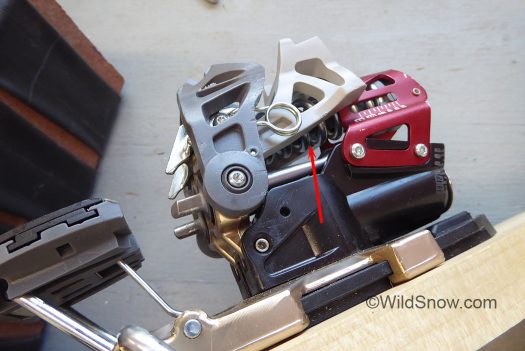Hey all, summer boredom strikes the heart of the boldest skiers… time to measure more bindings so this post stays updated.
Below, a bit of bench work regarding “elasticity” and “elastic travel” of touring bindings, defined as how far your boot can move in the release function and return to ski mode without ejecting (i.e., “return to center”). Thus ostensibly “absorbing” shock and vibration, in turn making your day safer.
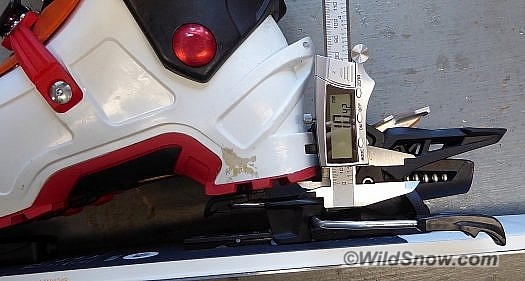
Fritschi Tecton yields what I’d call 10.5 millimeters of travel, as it can go slightly past my measurement point. Excellent (and virtually the same as 10 millimeters).
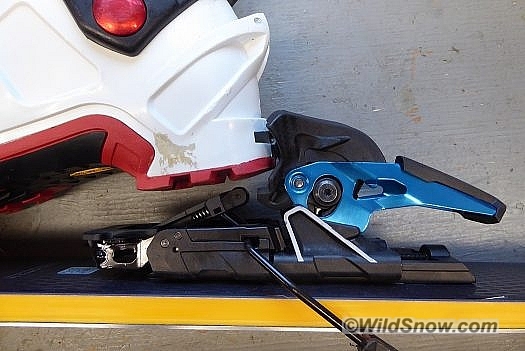
I evaluated the Atomic-Salomon Shift. Same. A bit more than 10 millimeters, which seems to be the practical limit of a ski binding with the common type of over-center heel unit. Note, I got a consistent 22 millimeters of lateral elastic travel at the toe, no photo.
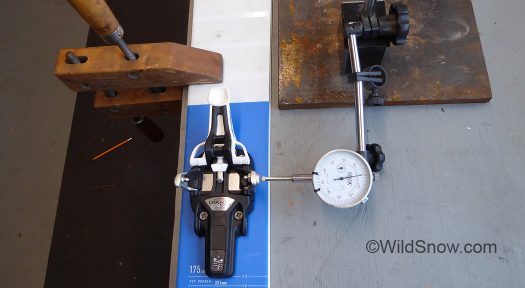
Vipec lateral travel test rig. I did not go to extremes with this, as it’s tough to measure to the exact moment of release. Thus, all measurements are for the sake of comparison and while accurate within a few millimeters are not intended as specifications.
Let’s talk vertical heel elasticity. It bears repeating that the classic tech binding configuration has minimal vertical travel at the heel, about 4 millimeters (compared to the alpine bindings having about ten millimeters). For smooth skiers used to tech bindings this tends to be a non issue, but with stiffer boots and aggressive skiing, many (if not most) riders find they need to dial up their classic tech binding heel vertical release settings for safe skiing, or otherwise experience the “insta-telemark” heel pop-out effect — leading immediately to a dangerous unintended binding release.
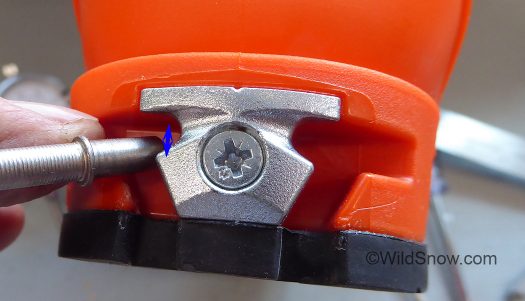
Vertical heel travel of a classic tech binding is dictated by how far the binding pins move down and out of the binding as your heel moves up, a minimal distance of about 4 millimeters as indicated by the arrow. Soft touring boots and smooth skiing obviate this as a performance factor, but go fast in big boots and you might find your heel popping up and out of the binding, unless you dial up your release value to stratospheric levels — essentially locking out the binding safety release function.
As of 2019, three bindings that accept most boots with tech fittings at the toe also provide vertical travel at the heel that doubles that of classic tech bindings: Fritschi Tecton; Trab TR2; Shift.
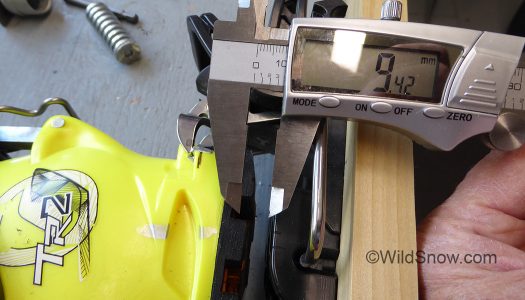
Trab vertical travel, measured just before the heel grabber goes over-center and releases boot heel.
Trab TR2 uses an elegant over-center pivot resisted by a beefy coil spring; yielding about 10 mm of travel. Downside is you have to actively hold the binding open with your ski pole to enter alpine mode.
Dynafit Beast (discontinued) has at least 11 millimeters of vertical heel travel, impressive and actually more than some alpine bindings, but with a twist. Beast vertical heel release occurs in two stages. First, a large coil spring absorbs energy and allows travel of about 8 mm with adjustable tension, then a set of classic tech style heel pins take over release function and ride down and out of the heel fitting just as with any other classic tech binding. Interestingly, the heel pins do not have adjustable release tension, and appear to be set at a release value of at least 10. Result is when set at higher values, Beast vertical release behaves normally, but when set to lower values you get a vertical release value “spike” when you engage the heel pins during the final part of the release. We thus only recommend Beast for skiers using high release values.
Marker Kingpin boasts a heel unit that behaves similar to a full-on alpine heel in vertical release and travel. Its ~9 millimeters of vertical travel is not as much as shelf appearance would indicate, but is virtually the same as our alpine binding benchmarks. Thus, excellent.
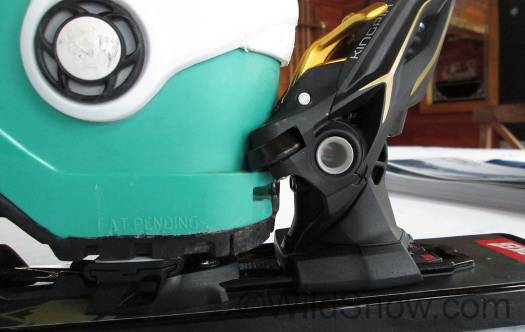
Marker Kingpin heel at first glance is a normal alpine unit, twist is it “twists” to the side to effect lateral release at the heel, similar to all classic tech bindings.
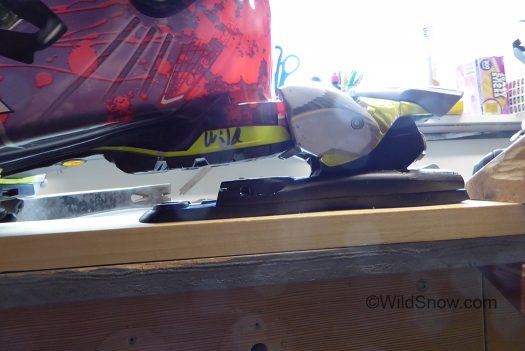
Our Salomon alpine binding benchmark for this evaluation has about 10 millimeters of vertical heel travel, a common range for alpine grabbers.
Heel vertical elasticity (range of travel before release):
– Alpine sample binding (Salomon): ~10 mm
– Dynafit Beast: ~ 11 mm (two-stage vertical heel release, first stage adjustable but second stage fixed, binding discontinued.)
– Fritschi Tecton: ~ 11 mm
– Trab TR2: ~10 mm
– Classic tech binding and Fritschi Vipec: ~4 mm
Toe lateral elasticity (only measured for “toe release bindings”
– Alpine sample binding (Salomon): ~20 mm
– Atomic-Salomon Shift: ~22 mm (I could go a few millimeters more but 22 is where consistent return to center occurred.)
– Fritschi Vipec & Tecton: ~17 mm
– Trab TR2: ~10 mm
Heel lateral elasticity (classic style tech binding and Dynafit Beast)
My instincts tell me it’s difficult to correlate/equate lateral heel travel with toe travel. So let us not go there. Suffice it to say that nearly any classic tech binding (side release at heel) has about 12 mm of travel when the heel unit rotates to the side. Tech bindings with rotating toes (i.e., Radical 2.0, have slightly more functional range due to the toe pins staying fully engaged with the toe sockets for the full range of motion, while classic binding pins ride out of the boot toe sockets and may become sensitive to pre-release when not fully engaged (that’s the party line, anyhow, while in my opinion such doesn’t matter unless you’re skiing aggressively, proven in real life by hundreds of thousands of skiers on classic tech bindings.)
In any case, only two tech (both toe and heel) bindings exist with lateral elasticity at the toe, as follows.
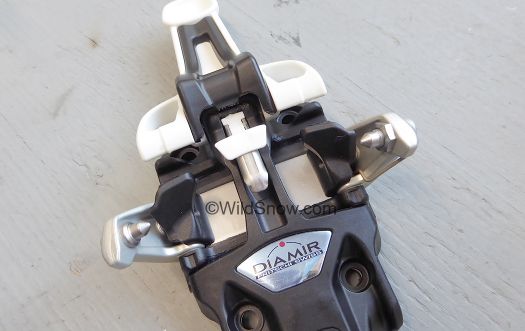
Fritschi Vipec Black toe. The toe pin ‘wings’ move to the side on a sliding carriage to provide travel and release.
Fritschi Diamir Vipec in its latest incarnation (Black, 12) has an impressive ~17 mm of travel due to a sliding carriage with lots of room to move. Other versions have 30% less travel that’s entirely adequate for most skiers. See this post for details.
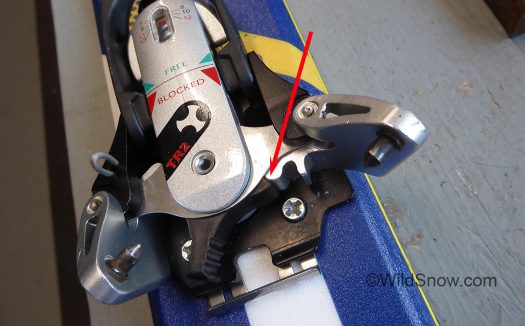
Trab has a simple and downright elegant system of spring loaded cams that go over-center to release the toe wings.
Trab TR 2 uses an interesting and quite elegant system of small spring-loaded pivots that engage with the toe wings. This system measured as about 10 millimeters of travel in my tests, around half what an alpine binding gives you but again in my opinion quite adequate for most skiers. As with Vipec, you have to reset the toe wings by hand after a lateral release.
In view of lateral elasticity, it’s worth mentioning Marker Kingpin as the appearance of the heel indicates it perhaps has superior lateral travel. Kingpin heel does have good lateral elasticity and return-to-center if adjusted properly and used with compatible boots (mandatory bench testing), nevertheless it has no more lateral travel than any other classic tech binding due to the finite limit created by the boot toe sockets riding on the binding toe pins.
What about “heel power?” You’ll hear marketing spreech about more “power” and a “solid feel” of the heel you get with Kingpin, Vipec and Trab due to various factors. On the bench, those bindings clearly clamp your boot with less rolling (cuff side-to-side) play than “normal” tech bindings. You can feel this when you ski various test rigs using the same boots. Do you ski better as a result, or have more fun? Your call.
In summary, while the vertical heel elasticity/travel of our “alpine like” test bindings easily matched that of many alpine bindings, lateral travel at the toe might be slightly less and varied quite a bit between brands. All these bindings in their most current iterations have field tested as mature products with no known defects. While we’re not sure if any of these bindings offer more protection from leg injury than classic tech bindings, they clearly have more elasticity/travel and thus could be better choices for aggressive skiers.
Note: Classic tech bindings do have spring loaded pressure holding the toe wings closed on your boot in alpine mode, and the amount of that pressure is important, but we don’t count this as providing travel or elasticity that can be compared to alpine-like binding toes. Nonetheless, it is important. read more here.
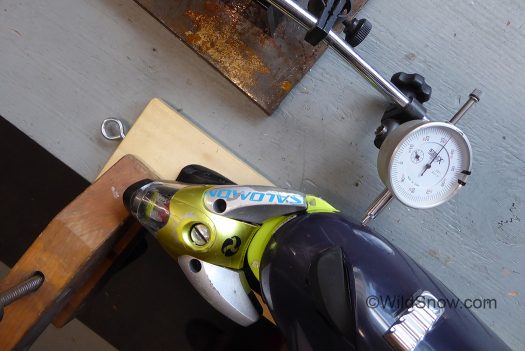
Decent quality alpine bindings have quite a bit of lateral travel at the toe, often assisted by a ‘forward pressure’ preload that helps the boot return to center when displaced. Forward pressure preload doesn’t help tech bindings and none have it, neither the “classic” tech bindings nor the new breed of hybrids. This is an important point, it may very well be that it’s impossible to build a lightweight toe-release tech binding with the return-to-center force of a modern alpine binding. Keep that in mind when you adopt tech bindings as your ‘quiver of one’ for all your skiing.
WildSnow.com publisher emeritus and founder Lou (Louis Dawson) has a 50+ years career in climbing, backcountry skiing and ski mountaineering. He was the first person in history to ski down all 54 Colorado 14,000-foot peaks, has authored numerous books about about backcountry skiing, and has skied from the summit of Denali in Alaska, North America’s highest mountain.

